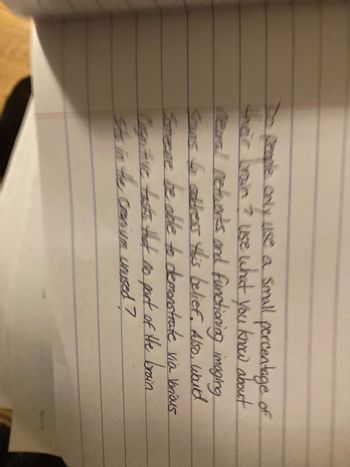
Ciccarelli: Psychology_5 (5th Edition)
5th Edition
ISBN: 9780134477961
Author: Saundra K. Ciccarelli, J. Noland White
Publisher: PEARSON
expand_more
expand_more
format_list_bulleted
Question

Transcribed Image Text:### Educational Insight: Understanding Brain Utilization
In the study of neuroscience, it is a common myth that people only use a small percentage of their brain, often quoted as less than 10%. Let's delve into what modern science has to say about this topic based on current research.
#### Functional Brain Imaging
Neuroimaging techniques, such as functional Magnetic Resonance Imaging (fMRI) and Positron Emission Tomography (PET) scans, have allowed scientists to observe the brain in action. These techniques have demonstrated that even simple activities can engage multiple areas of the brain, disproving the myth of limited brain usage.
#### Scientific Perspective
Renowned neuroscientists address this misconception through functional imaging studies. These studies consistently show that although at any given moment all areas of the brain might not be simultaneously active, over the course of a day every area of the brain shows some level of activity.
#### Brain Utilization Facts
- **Active Regions**: Different tasks stimulate different regions of the brain. For example, problem-solving, watching movies, or even simple conversations light up several cortical areas.
- **Neuroscientific Consensus**: This belief, often perpetuated by pop culture, lacks scientific backing. Brain mapping research shows comprehensive utilization across various functions and thoughts.
#### Demonstration through Diagrams
While we do not have specific diagrams here, imagine images showing brain activity during different tasks. Such images typically appear as heat maps, with active areas highlighted in bright colors like red and yellow, indicating higher levels of engagement, while cooler colors like blue and green show less active, though not inactive, regions.
### Conclusion
In summary, the idea that only a small fraction of the brain is used is a myth. Scientific investigations and neuroimaging provide concrete evidence supporting the active and functional engagement of the entire brain.
By learning about these advances, we gain a deeper appreciation for the complexity and capabilities of our brains, reinforcing the importance of continued research in neuroscience.
Expert Solution
This question has been solved!
Explore an expertly crafted, step-by-step solution for a thorough understanding of key concepts.
Step by stepSolved in 3 steps

Knowledge Booster
Recommended textbooks for you
 Ciccarelli: Psychology_5 (5th Edition)PsychologyISBN:9780134477961Author:Saundra K. Ciccarelli, J. Noland WhitePublisher:PEARSON
Ciccarelli: Psychology_5 (5th Edition)PsychologyISBN:9780134477961Author:Saundra K. Ciccarelli, J. Noland WhitePublisher:PEARSON Cognitive PsychologyPsychologyISBN:9781337408271Author:Goldstein, E. Bruce.Publisher:Cengage Learning,
Cognitive PsychologyPsychologyISBN:9781337408271Author:Goldstein, E. Bruce.Publisher:Cengage Learning, Introduction to Psychology: Gateways to Mind and ...PsychologyISBN:9781337565691Author:Dennis Coon, John O. Mitterer, Tanya S. MartiniPublisher:Cengage Learning
Introduction to Psychology: Gateways to Mind and ...PsychologyISBN:9781337565691Author:Dennis Coon, John O. Mitterer, Tanya S. MartiniPublisher:Cengage Learning Psychology in Your Life (Second Edition)PsychologyISBN:9780393265156Author:Sarah Grison, Michael GazzanigaPublisher:W. W. Norton & Company
Psychology in Your Life (Second Edition)PsychologyISBN:9780393265156Author:Sarah Grison, Michael GazzanigaPublisher:W. W. Norton & Company Cognitive Psychology: Connecting Mind, Research a...PsychologyISBN:9781285763880Author:E. Bruce GoldsteinPublisher:Cengage Learning
Cognitive Psychology: Connecting Mind, Research a...PsychologyISBN:9781285763880Author:E. Bruce GoldsteinPublisher:Cengage Learning Theories of Personality (MindTap Course List)PsychologyISBN:9781305652958Author:Duane P. Schultz, Sydney Ellen SchultzPublisher:Cengage Learning
Theories of Personality (MindTap Course List)PsychologyISBN:9781305652958Author:Duane P. Schultz, Sydney Ellen SchultzPublisher:Cengage Learning

Ciccarelli: Psychology_5 (5th Edition)
Psychology
ISBN:9780134477961
Author:Saundra K. Ciccarelli, J. Noland White
Publisher:PEARSON

Cognitive Psychology
Psychology
ISBN:9781337408271
Author:Goldstein, E. Bruce.
Publisher:Cengage Learning,

Introduction to Psychology: Gateways to Mind and ...
Psychology
ISBN:9781337565691
Author:Dennis Coon, John O. Mitterer, Tanya S. Martini
Publisher:Cengage Learning

Psychology in Your Life (Second Edition)
Psychology
ISBN:9780393265156
Author:Sarah Grison, Michael Gazzaniga
Publisher:W. W. Norton & Company

Cognitive Psychology: Connecting Mind, Research a...
Psychology
ISBN:9781285763880
Author:E. Bruce Goldstein
Publisher:Cengage Learning

Theories of Personality (MindTap Course List)
Psychology
ISBN:9781305652958
Author:Duane P. Schultz, Sydney Ellen Schultz
Publisher:Cengage Learning